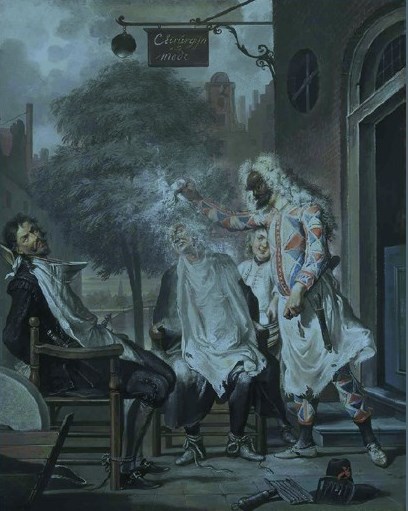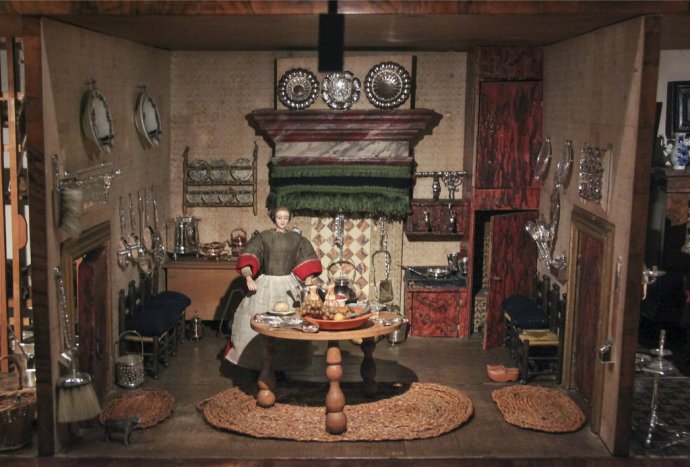
Sold Ceramics - Sold Japanese Blue and White wares 17th Century - Tableware and other Porcelain with Western Shapes - Page 2
Object 2012624
Shaving basin
Japan
1670-1690
Height 68 mm (2.68 inch), diameter of rim 276 mm (10.87 inch), diameter of footring 114 mm (4.49 inch), weight 1.096 grams (38.66 ounce (oz.))
Shaving bowl or barber's on footring. Spreading flat rim with a semicircular section saved in the lower part, two pierced holes on top. One the base one spur-mark. Decorated in underglaze blue with a vase filled with peonies on a terrace. The rim with peony scrolls. The reverse witg two sketchy landscapes with a [avilion and trees. Three circles round the foot, one on the base.
The first documentary evidence for scheerbeckens or shaving bowls is a 1662 invoice from the Director of the Deshima factory in Nagasaki regarding an order for 258 of these dishes for shipment to the Netherlands. After this point shaving dishes become a regular export item.
Shaving bowls were used by barbers and were indispensable in the Dutch household too. They were made of earthenware, pewter, copper and even silver. Beside their function as a shaving utensil, they had an alternative use, namely to let blood from a vein in the arm during blood-letting. This was a medical procedure thought to drain bad blood from the system, which was also performed by the barber/surgeon. In the seventeenth century, regulations were put in place in England to govern what barbers were permitted to do. Thus, they became confined to bloodletting and treating external diseases. In Prussia the barbers' and the surgeons' guild joined in 1779, and it was said of great Prussian surgeons that they had risen "up from the barber's bowl”. Both purposes explain the semi-circular saving. The two holes in the rim are for a cord or string. A shaving basin with the actual silk string still attached was excavated in Amsterdam. The string was used to suspend it from the client's neck to catch lather and water during shaving, or to hang the bowl on the wall thus implying that owners also appreciated the bowl for its decorative value as well as its function. Shaving bowls can be seen hanging on the wall as such in some dollhouses.

Cornelis Troost, Arlequin toovenaar en barbier, 1738, Mauritshuis, The Hague, Netherlands, inv. nr. 184. In spite of the satirical intent, the painting reflects actual usage.

The doll’s house of Petronella Dunois (1650-1695), c. 1676, Rijksmuseum, Amsterdam, the Netherlands, inv.nr. BK-14656. Two shaving dishes are suspended on the left wall.
Chinese shaving bowls usually have the holes in the footring instead of the rim. Most Japanese barber’s bowls are more or less rounded, whereas Chinese barber’s bowls usually are oval (for a Chinese example, please see Sold Archives object 2011301)
Larger pieces of Japanese porcelain such as plates, bowls and dishes, had a tendency to ‘sag’ during firing. That’s why they were often supported in the kiln by small stoneware pillars. After firing, these small cones or spurs which adhered to the base were knocked off, leaving behind small unglazed rough patches or spur marks on the base. The supports were arranged in X, Y or other patterns. Whether they have any relevance to dating or an attribution to a specific kiln is still unresolved. These spur marks are typically Japanese and are rarely seen on Chinese porcelain.
This shaving bowl shows one large spur, instead of several small spur marks, which is unusual.
For an almost identically decorated Japanese shaving bowl, please see:
- Hizen wares abroad, The 10th anniversary special exhibition, (Kyushu Ceramic Museum, Kyushu, 1990), p.39, Fig.38.
- Fine & Curious. Japanese Export Porcelain in Dutch Collections, (C.J.A. Jörg, Hotei Publishing, Amsterdam, 2003), p.184, cat. 227.
Condition: Some firing flaws due to the firing process.
References:
Price: Sold.


 create websites
create websites